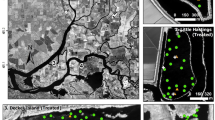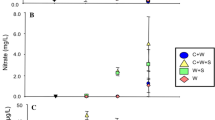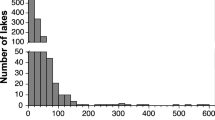Abstract
Anoxia can restrict species establishment in aquatic systems and the artificial promotion of these conditions can provide an effective control strategy for invasive molluscs. Low abundances (2–20 m−2) of the nonnative bivalve, Asian clam (Corbicula fluminea), were first recorded in Lake Tahoe, CA–NV in 2002 and by 2010 nuisance-level population densities (>10,000 m−2) were observed. A non-chemical control method using gas impermeable benthic barriers to reduce dissolved oxygen (DO) concentrations available to C. fluminea was tested in this ultra-oligotrophic natural lake. In 2009, the impact of ethylene propylene diene monomer (EPDM) sheets (9 m2, n = 6) on C. fluminea beds was tested on 1–7 day intervals over a 56 day period (August–September). At an average water temperature of 18 °C, DO concentrations under these small barriers were reduced to zero after 72 h resulting in 100 % C. fluminea mortality after 28 days. In 2010, a large EPDM barrier (1,950 m2) was applied to C. fluminea populations for 120 days (July–November). C. fluminea abundances were reduced over 98 % after barrier removal, and remained significantly reduced (>90 %) 1 year later. Non-target benthic macroinvertebrate abundances were also reduced, with variable taxon-specific recolonization rates. High C. fluminea abundance under anoxic conditions increased the release of ammonium and soluble reactive phosphorus from the sediment substrate; but levels of unionized ammonia were low at 0.004–0.005 mg L−1. Prolonged exposure to anoxia using benthic barriers can provide an effective short term control strategy for C. fluminea.






Similar content being viewed by others
References
Aldridge DW, McMahon RF (1978) Growth, fecundity and bioenergetics in a natural population of the Asiatic freshwater clam, Corbicula manilensis Philippi, from north central Texas. Journal of Molluscan Studies 44:49–70
Aldridge DW, Payne BS, Miller AC (1987) The effect of intermittent exposure to suspended solids and turbulence on three species of freshwater mussels. Environment Pollution 45:17–28
Anderson RO (1959) A modified flotation technique for sorting bottom fauna samples. Limnology and Oceanography 4:223–225
Baumgartner D, Mortl M, Rothhaupt KO (2008) Effects of water-depth and water-level fluctuations on the macroinvertebrate community structure in the littoral zone of Lake Constance. Hydrobiologia 613:97–107
Belanger SE (1991) The effect of dissolved oxygen, sediment, and sewage treatment plant discharges upon growth, survival and density of Asiatic clams. Hydrobiologia 218:113–126
Beutel MW, Horne AJ, Taylor WD, Losee RF, Whitney RD (2008) Effects of oxygen and nitrate on nutrient release from profundal sediments from a large, mesotrophic reservoir, Lake Mathews, California. Lake and Reservoir Management 24:18–29
Bidwell JR, Farris JL, Cherry DS (1995) Comparative response of the zebra mussel, Dreissena polymorpha, and the Asian clam, Corbicula fluminea, to DGH/QUAT, a nonoxidizing molluscicide. Aquatic Toxicology 33:183–200
Buckley YM, Hinz HL, Matthies D, Rees M (2001) Interactions between density dependent processes population dynamics and control of an invasive plant species, Tripleurospermum performatum (scentless chamomile). Ecology Letters 4:551–558
Burky AJ (1983) Physiological ecology of freshwater bivalves. In: Russel-Hunger WD (ed) The mollusca, vol 6, ecology. Academic Press, New York, pp 281–327
Cherry DS, Scheller JL, Cooper NL, Bidwell JR (2005) Potential effects of Asian clam (Corbicula fluminea) die-offs on native freshwater mussels (Unionidae) I: water-column ammonia levels and ammonia toxicity. Journal of the North American Benthological Society 24:369–380
Coats R, Perez-Losada J, Schladow SG, Richards R, Goldman CR (2006) The warming of Lake Tahoe. Climatic Change 76:121–148
Cohen RH, Dressler PV, Phillips EJP, Cory RL (1984) The effect of the Asiatic clam, Corbicula fluminea, on the phytoplankton of the Potomac River. Maryland. Limnology and Oceanography 29:170–181
Cooper NL, Bidwell JR, Cherry DS (2005) Potential effects of Asian clam (Corbicula fluminea) die-offs on native freshwater mussels (Unionidae) II: porewater ammonia. Journal of the North American Benthological Society 24:381–394
Davenport J, Woolmington AD (1982) A new method of monitoring ventilatory activity in mussels and its use in a study of ventilatory patterns of Mytilus edilus L. Journal of Experimental Marine Biology and Ecology 62:55–67
Doherty FG, Farris JL, Cherry DS, Cairns J (1986) Control of the freshwater fouling bivalve, Corbicula fluminea by halogenation. Archives of Environmental Contamination and Toxicology 15:535–542
Doherty FG, Cherry DS, Cairns J (1987) Valve closure responses of the Asiatic clam Corbicula fluminea exposed to cadmium and zinc. Hydrobiologia 153:159–167
Engel S (1984) Evaluating stationary blankets and removable screens for macrophyte control in lakes. Journal of Aquatic Plant Management 22:43–48
Engel S, Nichols SA (1984) Lake sediment alteration for macrophyte control. Journal of Aquatic Plant Management 22:38–41
Fast AW (1971) The invasion and distribution of the Asiatic clam (Corbicula manilensis) in a southern California reservoir. Bulletin of the Southern Californian Academy of Science 70:91–98
Finnoff D, Shogren JF, Leung B, Lodge DM (2007) Take a risk: preferring prevention over control of biological invaders. Ecological Economics 62:216–222
Frantz TC, Cordone AJ (1996) Observations on the macrobenthos of Lake Tahoe, California-Nevada. California Fish and Game Publication B2:1–41
Goldman CR (1988) Primary productivity, nutrients, and transparency during the early onset of eutrophication in ultra-oligotrophic Lake Tahoe, California-Nevada. Limnological and Oceanography 33:1321–1333
Goldman CR, Jassby A, Powell T (1989) Interannual fluctuations in primary production: meteorological forcing at two subalpine lakes. Limnological and Oceanography 34:310–323
Gordon ND, McMahon TA, Finlayson BL (1992) Stream hydrology: an introduction for ecologists. Wiley, New York, p 526
Goss LB, Cain C (1977) Power plant condensor and service water system fouling by Corbicula, the Asiatic clam. In: Jensen LD (ed) Biofouling control procedures: technology and ecological effects. Marcel Dekker, New York, p 11
Gray LJ (1981) Species composition and life histories of aquatic insects in a lowland Sonoran desert stream. American Midland Naturalist 106:229–242
Grieshaber MK, Hardewig I, Kreutzer U, Portner HO (1994) Physiological and metabolic responses to hypoxia in invertebrates. Reviews of Physiology, Biochemistry and Pharmacology 125:44–147
Gunnison G, Barko JW (1992) Factors influencing gas evolution beneath a benthic barrier. Journal of Aquatic Plant Management 30:23–28
Hakenkamp CC, Palmer MA (1999) Introduced bivalves in freshwater ecosystems: the impact of Corbicula on organic matter dynamics in a sandy stream. Oecologia 119:445–451
Hornbach DJ (1992) Life history traits of a Riverine population of the Asian Clam Corbicula fluminea. American Midland Naturalist 127:248–257
Isom BG (1986) Historical review of Asiatic clam (Corbicula) invasion and biofouling of waters and industries in the Americas. Proceedings of the second international Corbicula symposium, 2 edn of the American Malacological Bulletin
Jenner HA (1990) Biomonitoring in chlorination anti-fouling procedures to achieve discharge concentrations as low as possible. International Macrofouling Symposium Notebook, Electric Power Research Institute, Palo Alto, pp 9–11
Johnson KI, Henager CH, Page TL, Hayes PF (1986) Engineering factors influencing Corbicula fouling in nuclear service water systems. Proceedings of the Second International Corbicula Symposium. Special Edition No. 2 of the American Malacological Bulletin, June
Karatayev AY, Burlakova LE, Kesterson T, Padilla DK (2003) Dominance of the Asiatic clam, Corbicula fluminea (Muller), in the benthic community of a reservoir. Journal of Shellfish Research 22:487–493
Keller RP, Frang K, Lodge DM (2008) Preventing the spread of invasive species: economic benefits of intervention guided by ecological predictions. Conservation Biology 22:80–88
Lee AC, Lee MC, Lee YH, Lee YC (2008) Candidates for a hypoxia-stress indicator in the hard clam, Meretrix lusoria. Aquaculture 278:150–155
Leung B, Lodge DM, Finnoff D, Shogren JF, Lewis MA, Lamberti G (2002) An ounce of prevention or a pound of cure: bioeconomic risk analysis of invasive species. Proceedings of the Royal Society London B 269:2407–2413
Liddicoat MI, Tibbits S, Butler EI (1975) The determination of ammonia in seawater. Limnological and Oceanography 20:131–132
Lieb DA, Bouchard RW, Carline RF, Nuttall TR, Wallace JR, Burkholder CL (2011) Conservation and management of crayfishes: lessons from Pennsylvania. Fisheries 36:489–507
Mack RN, Simberloff D, Lonsdale WM, Evans H, Clout M, Bazzaz FA (2000) Biotic invasions: causes, epidemiology, global consequences, and control. Ecological Applications 10:689–710
Malmqvist B, Rundle S, Birsnmark C, Erlandsson A (1991) Invertebrate colonization of a new, man-made stream in southern Sweden. Freshwater Biology 26:307–324
Matthews MA, McMahon RF (1999) Effects of temperature and temperature acclimation in survival of zebra mussels (Dreissena polymorpha) and Asian clams (Corbicula fluminea) under extreme hypoxia. Journal of Molluscan Studies 65:317–325
Mattice JS, McLean RB, Burch MB (1982) Evaluation of short-term exposure to heated water and chlorine for control of the Asiatic clam (Corbicula fluminea). Oak Ridge National Laboratory, Environmental Science Division, Publication No. 1748. U.S. National Technical Information Service, Department of Commerce, Springfield, VA, p 33
McMahon RF (1982) The occurrence and spread of the introduced Asiatic freshwater clam, Corbicula fluminea (Muller) in North America 1924–1982. Nautilus 96:134–141
McMahon RF (1996) The physiological ecology of the zebra mussel, Dreissena polymorpha, in North America and Europe. American Zoologist 36:339–363
McMahon RF (1999) Invasive characteristics of the freshwater bivalve, Corbicula fluminea. In: Claudi R, Leach JH (eds) Nonindigenous freshwater organisms: vectors, biology and impacts. Lewis Publishers, Boca Raton, pp 315–343
McMahon RF, Lutey RW (1988) Field and laboratory studies of the efficacy of poly-[oxyethylene(dimethyliminio)ethylene(dimenthyliminio)ethylene dichloride] as a biocide against the Asian clam, Corbicula fluminea. In: Proceedings: service water reliability improvement seminar. Electric Power Research Institute, Palo Alto,pp 61–72
Merritt RW, Cummins KW (1996) An introduction to the aquatic insects of North America, 3rd edn. Kendal/Hunt Publishing Company, Dubuque, p 1158
Murphy J, Riley JP (1962) A modified single-solution method for the determination of phosphate in natural waters. Analytical Chimica Acta 27:31–36
Myers JH, Simberloff D, Kuris AM, Carey JR (2000) Eradication revisited: dealing with exotic species. Trends in Ecology and Evolution 15:316–320
Nichols SA (1974) Mechanical and habitat manipulation for aquatic plant management. Wisconsin Department of Natural Resources Technical Bulletin #77
Ortmann C, Grieshaber MK (2003) Energy metabolism and valve closure behaviour in the Asian clam Corbicula fluminea. The Journal of Experimental Biology 206:4167–4178
Otermin A, Basaguren A, Pozo J (2002) Re-colonization by the macroinvertebrate community after a drought period in a first-order stream (Agüera Basin, Northern Spain). Limnetica 21:117–128
Sala OE, Chapin FS, Huber-Sannwald E (2001) Potential biodiversity change: global patterns and biome comparisons. In: Sala OE, Chapin FS, Huber-Sannwald E (eds) Global biodiversity in a changing environment: scenarios for the 21st century. Springer, New York, pp 351–367
Simberloff D (1999) Eradication. In: Simberloff D, Schmitz C, Brown TC (eds) Strangers in paradise. Island Press, Washington, DC, pp 221–228
Solorzano L (1969) Determination of ammonia in natural waters by the phenolhypocholorite method. Limnological and Oceanography 14:799–801
Stites DL, Benke AC, Gillespie DM (1995) Population-dynamics, growth, and production of the Asiatic clam, Corbicula fluminea, in a Blackwater River. Canadian Journal of Fisheries and Aquatic Sciences 52:425–437
Taylor AC (1976) The cardiac responses to shell opening and closure in the bivalve Artcia islandica. Journal of Experimental Biology 64:751–759
Thorp JH, Covich AP (2001) Ecology and classification of North American freshwater invertebrates, 2nd edn. Academic Press, San Diego, p 1056
Thurston RV, Russo RC, Emerson K (1979) Aqueous ammonia equilibrium tabulation of percent un-ionized ammonia. EPA/600/3-79-091. Environmental Research Laboratory, US Environmental Protection Agency, Duluth
Ussery TA, Eakin HL, Payne BS, Miller AC, Barko AW (1997) Effects of benthic barriers on aquatic habitat conditions and macroinvertebrate communities. Journal of Aquatic Plant Management 35:69–73
VanderZanden MJ, Chandra S, Park S, Vadeboncoeur Y, Goldman CR (2006) Efficiencies of benthic and pelagic trophic pathways in a subalpine lake. Canadian Journal of Fisheries and Aquatic Sciences 63:2608–2620
Werner S, Rothhaupt KO (2007) Effects of the invasive bivalve Corbicula fluminea on settling juveniles and other benthic taxa. Journal of the North American Benthological Society 26:673–680
Wetzel RG (2001) Limnology: lake and river ecosystems, 3rd edn. Academic Press, New York, p 767
White SW, White SJ (1977) The effect of reservoir fluctuations on populations of Corbicula manilensis (Pelecypoda: Corbiculidae). Proceedings of the Oklahoma Academy of Science 57:106–109
Widdows J (1987) Application of calorimetric methods in ecological studies. In: James AM (ed) Thermal and energetic studies of cellular biological systems. IOP Publishing Limited, Bristol, pp 182–215
Zavaleta ES, Hobbs RJ, Mooney HA (2001) Viewing invasive species removal in a whole-ecosystem context. Trends in Ecological Evolution 16:454–459
Zipkin EF, Sullivan PJ, Cooch EG, Kraft CE, Shuter BJ, Weidel BC (2008) Overcompensatory response of a smallmouth bass population to harvest: release from competition? Canadian Journal of Fisheries and Aquatic Sciences 65:2279–2292
Zipkin EF, Kraft CE, Cooch EG, Sullivan PJ (2009) When can efforts to control nuisance and invasive species backfire? Ecological Applications 19:1585–1595
Acknowledgments
This work was funded by the Southern Nevada Public Land Management Act and the Nevada Division of State Lands with support by the Tahoe Regional Planning Agency, U.S. Fish and Wildlife Service and the Lahontan Regional Water Quality Control Board. We would like to thank David Aldridge, Robert McMahon, Karen Gehrts, Manfried Grieshaber for their expert advice and guidance on this research. We would also like to thank Zach Hymanson, Tamara Sasaki, Cathie Preston, Anne Liston, Veronica Edirveerasingam-Alumbaugh, Scott Hackley, Steve Sesma, Christine Ngai-Ryan, Todd Steissberg, Annie Caires, Matt Daniels, Joe Sullivan and Marianne Denton for their assistance in the data collection, sample processing and analysis.
Author information
Authors and Affiliations
Corresponding author
Rights and permissions
About this article
Cite this article
Wittmann, M.E., Chandra, S., Reuter, J.E. et al. The Control of an Invasive Bivalve, Corbicula fluminea, Using Gas Impermeable Benthic Barriers in a Large Natural Lake. Environmental Management 49, 1163–1173 (2012). https://doi.org/10.1007/s00267-012-9850-5
Received:
Accepted:
Published:
Issue Date:
DOI: https://doi.org/10.1007/s00267-012-9850-5




